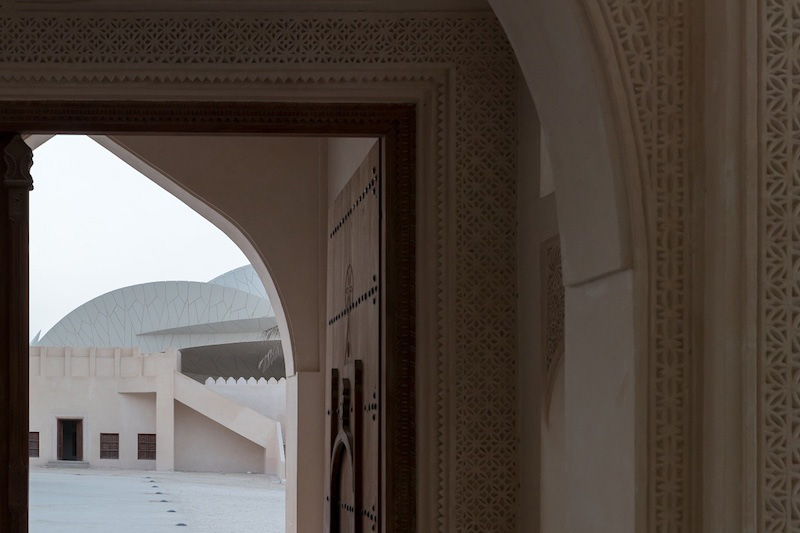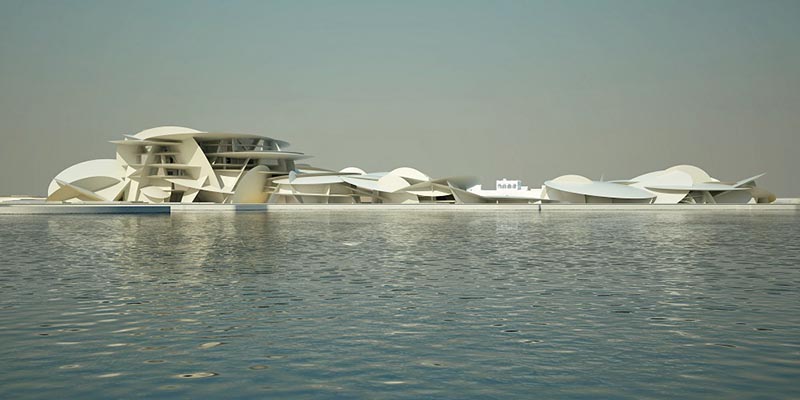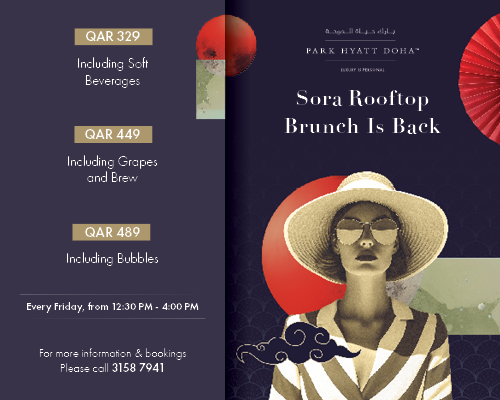There are many sights to capture the eye while driving along the Doha Corniche – the skyline is one of the most mesmerising sights in Qatar. However, the most prominent building on the Doha Corniche is the new National Museum of Qatar (NMoQ), which officially opened this week.
An Iconic Building
 Crystal-like with a series of propagating interlocked discs, the striking museum is inspired by the desert rose, the colloquial name given to rose-like formations of crystal clusters of gypsum or baryte which include abundant sand grains. The desert rose has been found in the northeast of Qatar, most notably at Jebel Al Jassasiya, near Fuwairit. The interlocking discs that make up the building are representative of petals, each positioned at different angles. The discs are made of steel truss structures assembled in a hub-and-spoke arrangement, clad in glass fibre reinforced concrete panels.
Crystal-like with a series of propagating interlocked discs, the striking museum is inspired by the desert rose, the colloquial name given to rose-like formations of crystal clusters of gypsum or baryte which include abundant sand grains. The desert rose has been found in the northeast of Qatar, most notably at Jebel Al Jassasiya, near Fuwairit. The interlocking discs that make up the building are representative of petals, each positioned at different angles. The discs are made of steel truss structures assembled in a hub-and-spoke arrangement, clad in glass fibre reinforced concrete panels.
The museum was designed by the world-renowned French architect Jean Nouvel, who also designed The Louvre Abu Dhabi. According to the Pritzker Prize-winning architect, the building is meant to represent the country’s desert location alongside the sea.
Everything in this museum works to make the visitor feel the desert and the sea.’
Talking about the identity form of NMoQ on his website, Nouvel says, ‘the National Museum of Qatar is proof patent of how intense this energy is. Of course it will be home to the traditional geological and archaeological artefacts; of course tents, saddles and the dishes will bear witness to nomadic life; of course there will be fishermen’s utensils, boats and nets.’
Most importantly, though, it will spark an awareness that could only otherwise be encountered, experienced, after months spent in the desert, in pursuit of the particularities that elude our grasp except when the whims of Time and Nature allow.’
Construction of NMoQ began in 2010. In June 2017, HE Sheikha Al Mayassa bint Hamad Al Thani, chairperson of Qatar Museums (QM), announced a target opening date of December 2018. Soon after in July 2017, QM kicked off a series of exclusive tours of the NMoQ for its Culture Pass programme members. With a total of 50 tours, hundreds of residents got a sneak peek of the iconic structure.
The museum is built around Sheikh Abdullah bin Jassim Al Thani’s original palace – his family home and seat of government for 25 years. The landmark was restored by Berlin-based architecture studio Ziegert Roswag Seiler Architekten Ingenieure in 2014 and will be incorporated into the museum as its central exhibit.
The project has a total gross area of 40,000 sq metres, providing 8,000 sq metres of permanent and 2,000 sq metres of temporary gallery space. It also includes a 115,000-sq metre park with an artificial lagoon and parking for 400 vehicles, a research centre, laboratories, a dedicated food forum, restaurants and cafes, and a museum shop.
Each gallery along the museum’s winding, 1.5-km path is a unique, encompassing environment, which tells its part of the story of Qatar through a special combination of architectural space, music, poetry, oral histories, evocative aromas, archaeological and heritage objects, commissioned artworks, scaled films, and more. Together, the 11 permanent galleries take visitors from the formation of Qatar millions of years ago to the nation’s exciting and diverse present, giving voice to the rich heritage and culture of the people expressing their aspirations for the future.
The NMoQ is the only project from the region to feature in the ‘Best New Architectures of 2018’ listing. Previously, the museum won the international award for ‘Façade Design and Engineering of the Year’ at the ABB LEAF Awards. The internationally renowned MIPIM Awards named the NMoQ as the ‘Best Futura Project’ for its architectural and engineering qualities during their annual ceremony in Cannes in May 2018.
ASTAD provided Project and Construction Management consultancy throughout the development of the museum. For the third year in a row, ASTAD was ranked within the top 10 global construction and project management firms and is the first Arab company to hold this title for three consecutive years by Engineering News-Record (ENR).
In addition, ASTAD has also won ‘Best Infrastructure Project Management Team’ in the GCC by CFI Awards in the UK and several other of their projects have won prestigious awards including the NMoQ, Qatar National Library (QNL) and Sidra Medicine.
New Brand Identity
As it neared its opening date, the NMoQ was the focus of several high-profile initiatives, the unveiling of its new brand identity and the launch of the popular ‘Voices’ campaign. The Voices are members of the local community, representing all nationalities, age groups and professions, who have been asked to share their stories and memories of the old national museum to emphasise NMoQ’s focus on telling the story of the people of Qatar through their eyes.
In April 2018, QM unveiled a new brand identity for the iconic NMoQ. The new brand and logo is the centrepiece of an innovative digital media campaign designed to build maximum visibility and awareness among the local population for the museum and all that it stands for.
The logo design combines three doorways evocative of the Old National Museum, and which signifies Qatar’s past, present and future – reflecting the museum’s central narrative and what it has come to symbolise.
The design was developed by a team of brand and creative experts at QM to do justice to the layers of meaning and significance that NMoQ, its content and programmes hold for the country and its people.
Inside the Museum

The museum aims to be a thriving hub for the public, students and museum professionals. According to QM, the museum gives voice to Qatar’s heritage while celebrating its future. At the museum, visitors can learn about Qatar’s ancestors and the formation of early cities, as well the modernisation of Qatari society. Exhibitions combine historic objects and contemporary influences, opening up a dialogue around the impact of rapid change.
One of the most notable features of the museum is its innovative presentation techniques. Entire walls can become cinematic screens, individual cocoons hold oral histories and handheld mobile devices guide people through thematic displays.
In addition, the museum showcases the nation’s maritime history, committed to preserving the dhows that were once Qatar’s lifeblood. The museum is particularly interested in preserving and recreating the dhows that once sailed the Arabian Gulf for trade, pearls, and fishing. Historic objects will be on display within exhibits about the country’s ancestors, early cities, and modern society. Teams have explored original building methods using laser scanning and digital photography, and created 3D digital models of the vessels, which are accessible to and which intrigue a wide audience. They assist in conserving one of the Arabian-Persian Gulf’s maritime traditions.
NMoQ began shifting parts of its expansive collection to the new museum building from the beginning of 2018. At least 1,500 artefacts were transferred into the new building, however, only portions of NMoQ’s vast collection will be on display at any given time.
During the preliminary preparation phase, the NMoQ team identified and sorted all collection items into three categories, comprising artefacts containing organic materials such as leather, textile or wood that needed to be frozen prior to entering the new facility, artefacts with inorganic materials such as metals, stones or ceramics that did not require freezing, and fragile items that required special packing. This process helped guide the careful transportation of each artefact to ensure it was preserved and cared for properly on the way to its new home. Thousands of artefacts will be on display at the museum, supported by large format film displays that immerse visitors into Qatar’s art, heritage and culture.
The museum represents one of the most significant cultural projects in the country and also one of the most ambitious museum projects of its kind, anywhere in the world.
Author: Ola Diab
Copyright © Marhaba Information Guide. Reproduction of material from Marhaba Information Guide’s book or website without written permission is strictly prohibited. Using Marhaba Information Guide’s material without authorisation constitutes as plagiarism as well as copyright infringement.






